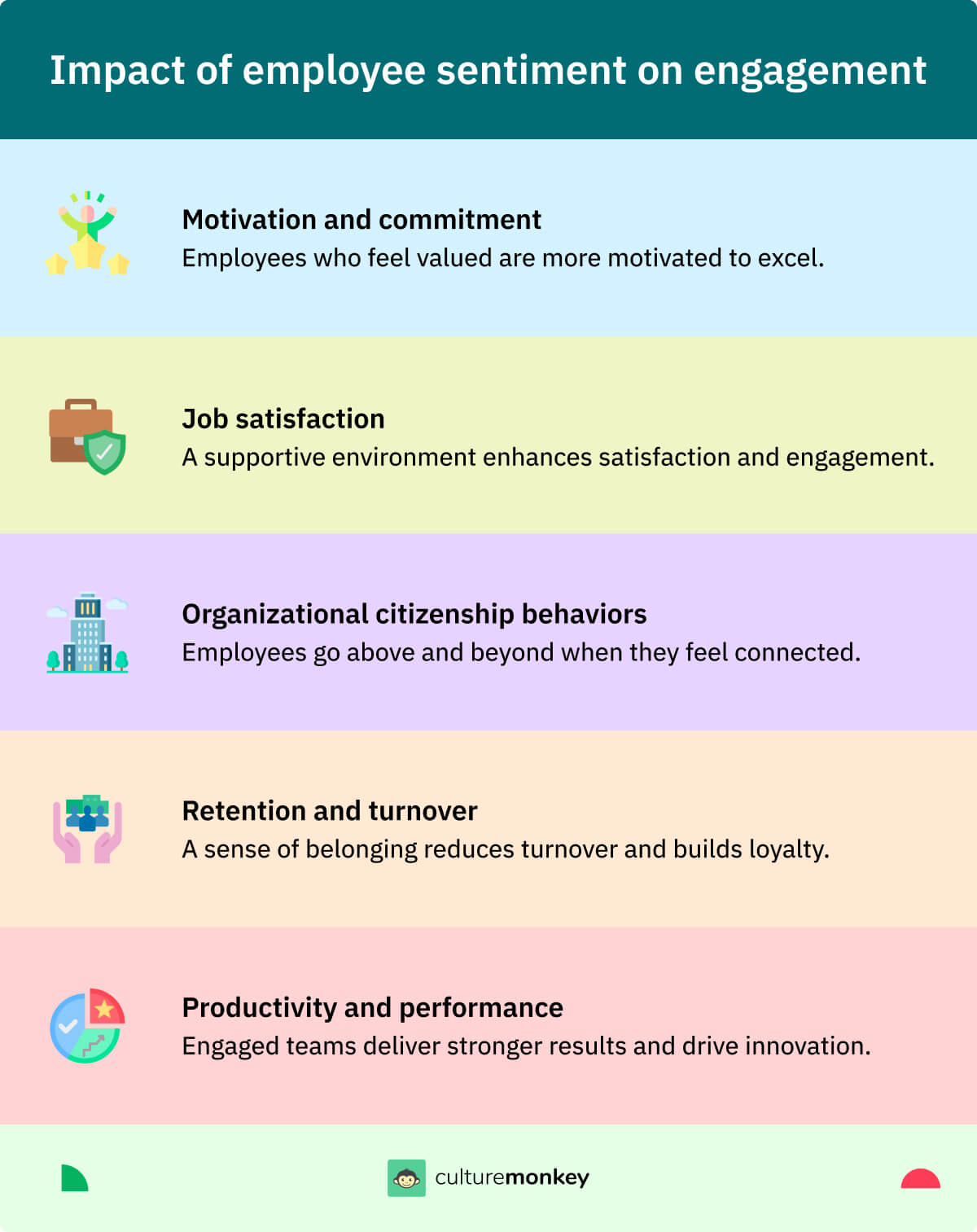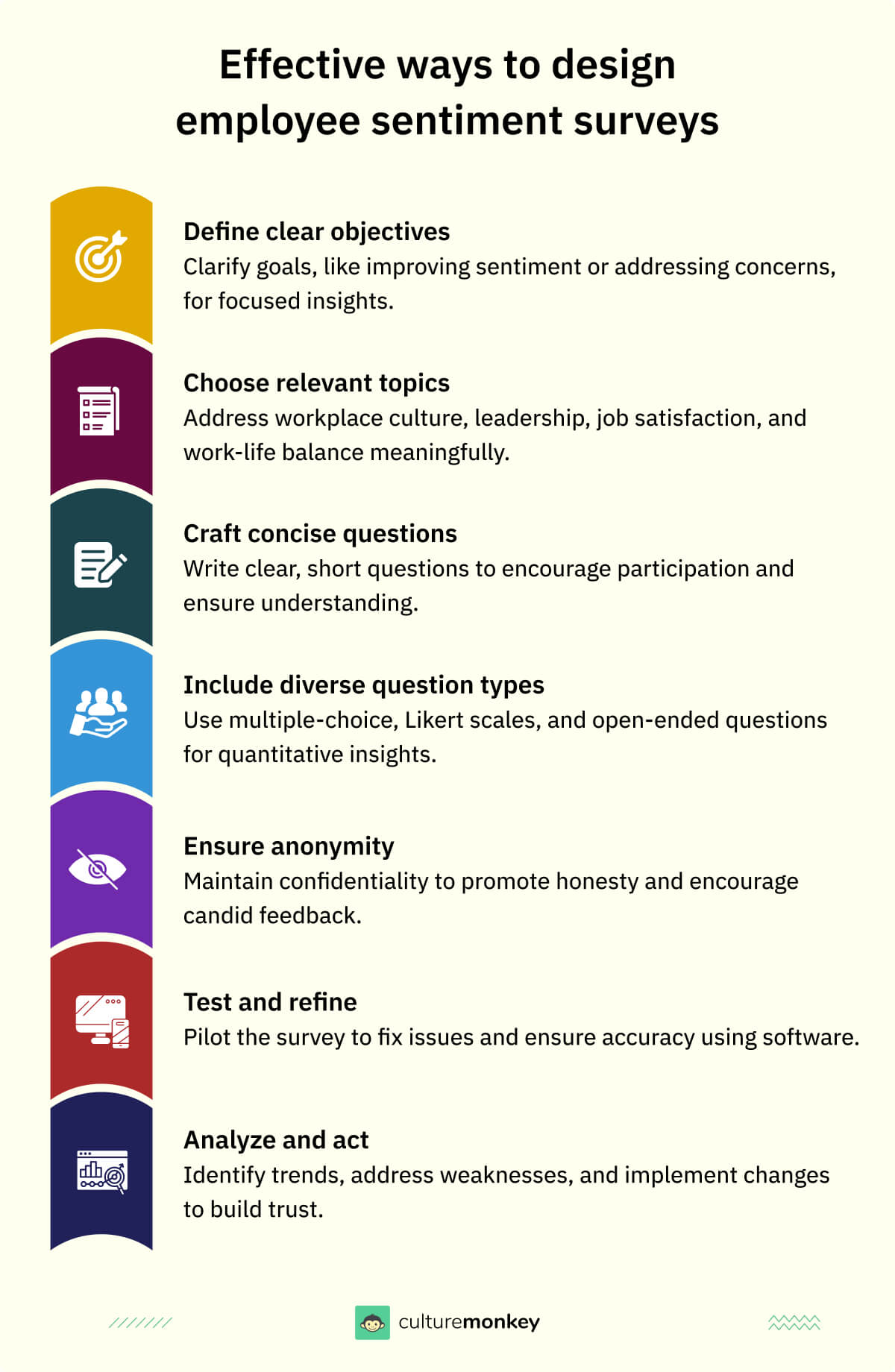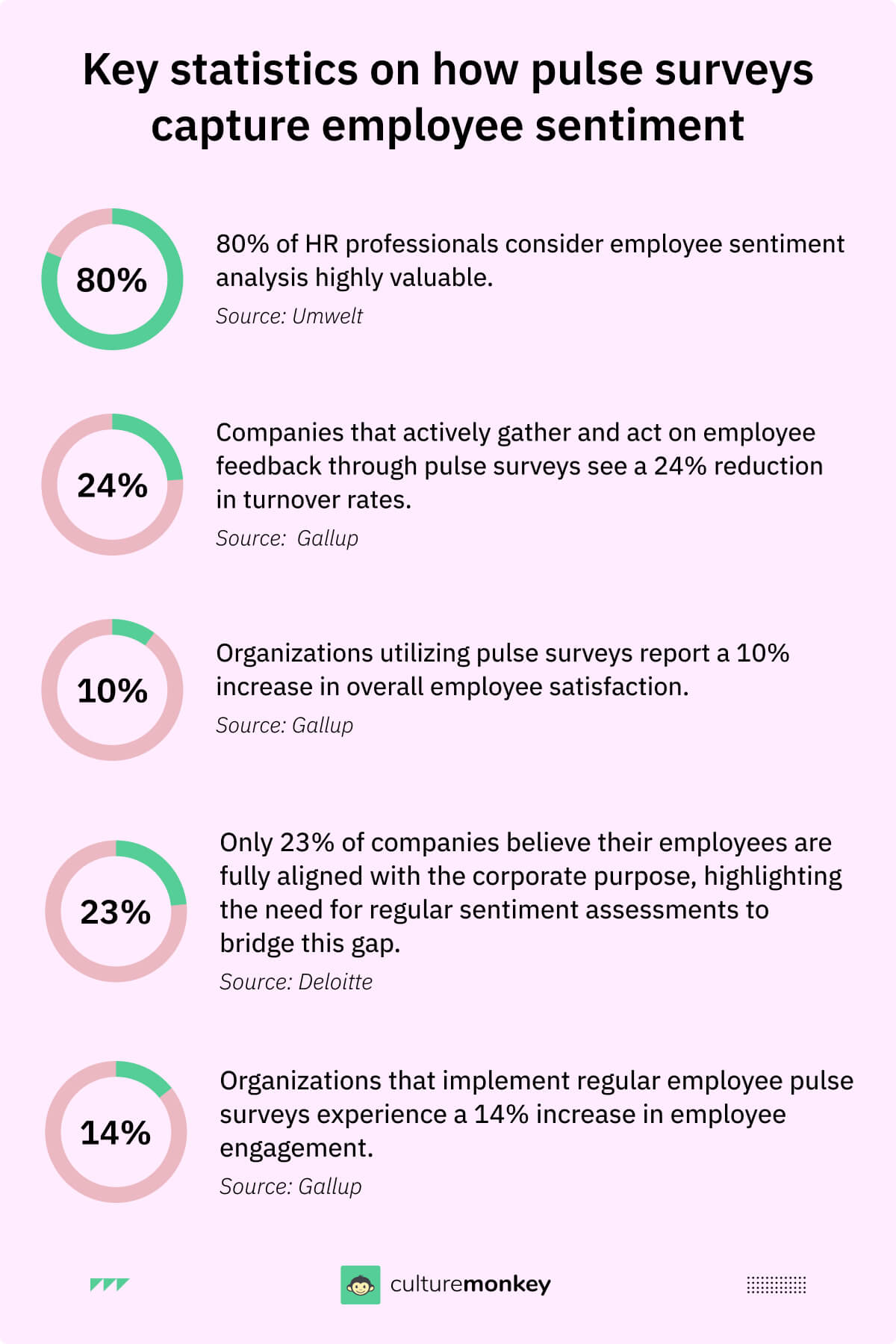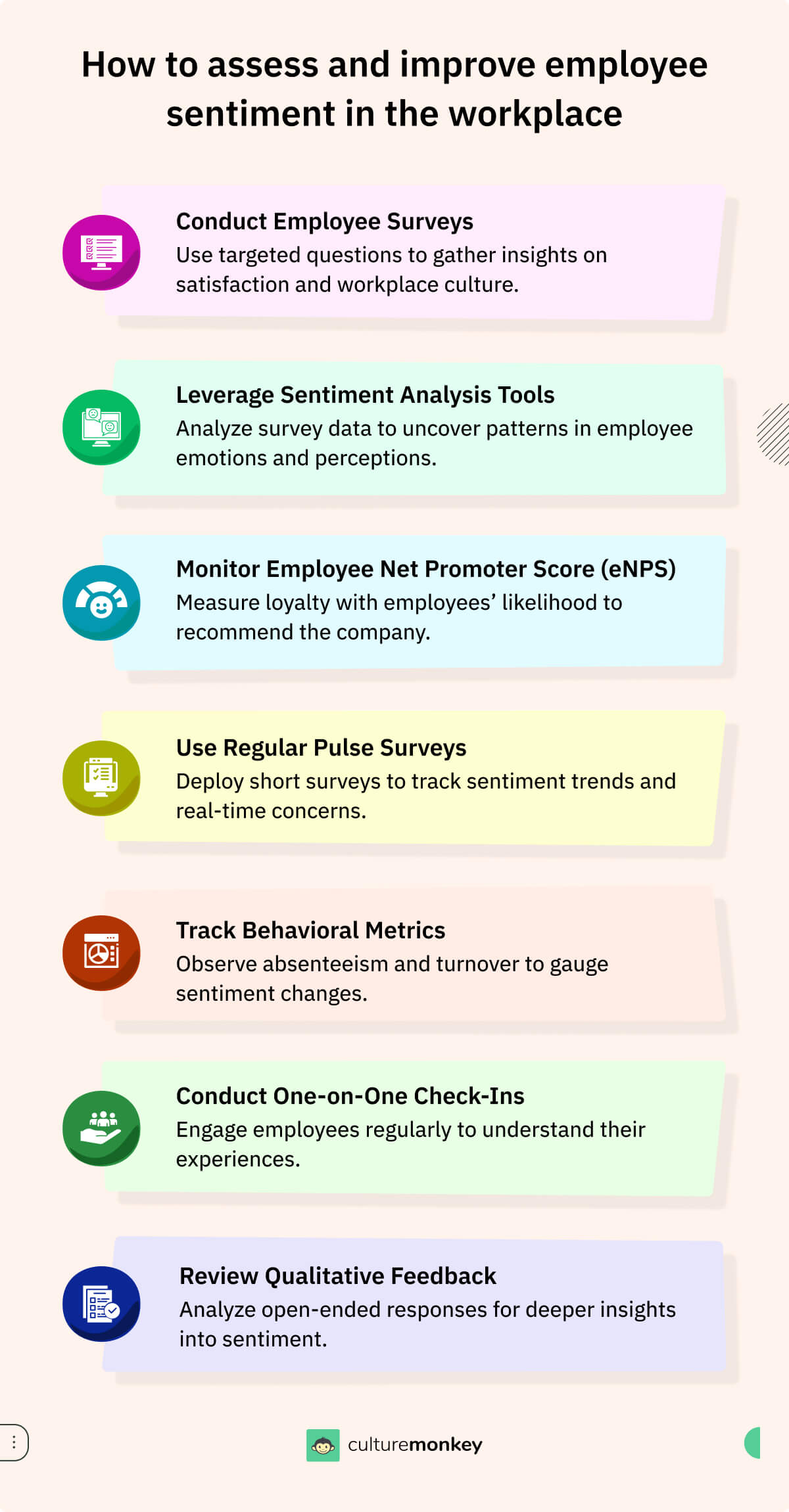Tracking employee sentiment in 2025: Master the art of pulse assessment

Understanding employee sentiment is like reading the weather forecast for your organization, ignoring it can lead to storms of disengagement, while paying attention helps you navigate toward sunnier days.
Just as weather patterns indicate the climate’s health, employee sentiment reflects the emotional and psychological state of your workforce. It’s more than just a “nice-to-know” metric; it’s a critical indicator of engagement, satisfaction, and overall well-being.
Organizations that prioritize understanding employee sentiment gain valuable insights to create a supportive environment, address challenges, and foster a culture of trust and belonging - key ingredients for driving long-term success and employee retention.
By leveraging tools like sentiment analysis surveys, leaders can identify patterns and implement actionable strategies that directly enhance workplace satisfaction and productivity.
Blog Highlights


What is employee sentiment?

Employee sentiment is the comprehensive amalgamation of the myriad emotions, attitudes, and perceptions that collectively define the workforce's disposition within an organization.
It serves as a barometer reflecting the intricate interplay between employees' experiences, their interactions with colleagues and supervisors, their perception of workplace culture, and their overall satisfaction with their roles.
When you measure sentiment, you gather the breadth of emotions, from joy and contentment to frustration and disillusionment, that color the workplace landscape. This emotional undercurrent influences employee behavior, engagement levels, and, ultimately, organizational performance.
Measuring sentiment has become increasingly paramount in contemporary workplaces, especially amidst the evolving dynamics of the modern workforce. Employers are slowly coming to recognize the indispensable role that sentiment plays in shaping organizational outcomes.
What is the impact of employee sentiment on employee engagement?

The impact of employee sentiment on engagement is profound and multifaceted, with a symbiotic relationship existing between the two. Here's a detailed exploration of how employee sentiment influences engagement:
Motivation and commitment
Positive sentiment fosters a sense of motivation and commitment among employees. When employees feel valued, respected, and appreciated within the organization, they are more likely to be emotionally invested in their work.
This emotional investment translates into higher levels of engagement, as employees are driven to contribute their best efforts towards achieving organizational goals.
Job satisfaction
Employee sentiment directly correlates with job satisfaction – the extent to which employees feel fulfilled and content in their roles.
When employees perceive their work environment positively, enjoy meaningful relationships with colleagues and supervisors, and feel that their contributions are recognized and valued, they are more likely to experience higher levels of job satisfaction.
This, in turn, fuels their engagement, as satisfied employees are more inclined to invest their time and energy in their work.
Organizational citizenship behaviors
Positive sentiment cultivates a culture of organizational citizenship behaviors, wherein employees go above and beyond their prescribed roles to support the organization and their colleagues.
Employees who feel a strong sense of connection and loyalty towards their organization are more likely to engage in discretionary behaviors such as helping coworkers, volunteering for additional tasks, and contributing innovative ideas. These behaviours contribute to the overall effectiveness and success of the organization.
Retention and turnover
Employee sentiment significantly influences employee retention rates. When employees feel valued, respected, and engaged, they are more likely to remain with the organization for the long term.
Conversely, negative sentiment, characterized by feelings of disengagement, dissatisfaction, or disillusionment, can lead to increased turnover rates as employees seek opportunities elsewhere.
High turnover not only disrupts organizational continuity but also incurs significant costs associated with recruitment, training, and onboarding of new former and current employees both.
Productivity and performance
Engaged employees are more productive and perform at higher levels than their disengaged counterparts.
Positive sentiment creates an environment where employees are motivated to excel, collaborate effectively, and contribute towards achieving organizational objectives. This heightened productivity positively impacts the organization's bottom line, driving innovation, efficiency, and overall performance.
Employee sentiment versus employee engagement: What’s the difference?
| Aspect | Employee sentiment | Employee engagement |
|---|---|---|
| Definition | Refers to employees' emotions and perceptions about their workplace. | Refers to employees' commitment and motivation toward their roles and goals. |
| Focus area | Focuses on how employees feel. | Focuses on what employees do. |
| Measurement | Measured through surveys and sentiment analysis tools. | Measured through engagement surveys and performance metrics. |
| Indicators | Emotional indicators like satisfaction and morale. | Behavioral indicators like participation and dedication. |
| Purpose | Aims to improve emotional well-being and communication. | Aims to boost productivity and alignment with organizational goals. |
| Insights | Leads to actions enhancing workplace relationships and morale. | Drives initiatives for better performance and recognition. |
What is an employee sentiment survey?

An employee sentiment survey is a structured tool used by organizations to systematically measure and assess the attitudes, perceptions, and emotions of their employees towards various aspects of their work environment, job roles, and organizational culture.
These surveys are designed to gather feedback from employees regarding their experiences, satisfaction levels, engagement, and overall sentiment within the organization.
These surveys typically consist of a series of questions that are carefully crafted to elicit honest and candid responses from employees.
They are an essential tool and cover topics such as job satisfaction, workplace culture, engagement, relationships with supervisors and colleagues, feedback mechanisms, work-life balance, and recognition.
These surveys help organizations gather honest feedback to inform decision-making and initiatives aimed at improving employee well-being and organizational effectiveness.
What is an employee sentiment score?

An employee sentiment score is a quantitative measure that reflects the overall sentiment or emotional state of employees within an organization. It is typically derived from the analysis of data collected through sentiment surveys, feedback mechanisms, or other assessment tools.
The sentiment score is calculated based on various factors, including responses to survey questions, sentiment analysis of employee comments or feedback, and key indicators related to job satisfaction, engagement, and workplace culture.
This score provides organizations with a standardized metric to assess the overall mood and sentiment of their workforce, enabling them to identify areas of strength, areas for improvement, and trends over time.
A higher sentiment score indicates positive employee sentiment, while a lower score may indicate areas of concern or dissatisfaction that require attention.
Why is employee sentiment analysis important?

Employee sentiment analysis is a critical tool for understanding the emotional pulse of your workforce. It enables organizations to identify challenges, celebrate successes, and implement targeted strategies that foster a thriving workplace. Here’s why it’s essential:
- Enhances employee well-being: By identifying emotions like stress, satisfaction, or frustration, organizations can use sentiment analysis on employee feedback to address mental and emotional health issues.
- Boosts engagement: Positive sentiment correlates with higher engagement. Employers can improve employee sentiment by using insights from engagement surveys to align employee goals with organizational objectives.
- Reduces turnover: Sentiment analysis reveals early signs of dissatisfaction or disengagement, helping organizations retain employees and reduce costs through employee sentiment analysis software.



When people are financially invested, they want a return. When people are emotionally invested, they want to contribute.
Author
- Strengthens workplace culture: Analyzing employee culture sentiment helps align organizational values with employee expectations, fostering inclusivity and collaboration.
- Improves leadership effectiveness: Employee sentiment analysis tools provide leaders with actionable insights into their management practices, strengthening communication and trust.
- Informs strategic decisions: Data from employee sentiment surveys guides decision-making in areas like training programs and resource allocation.
- Builds trust and transparency: Regular sentiment surveys demonstrate a commitment to improving current employee sentiment, fostering open communication and satisfaction.
How to design an effective employee sentiment survey

Designing an effective employee sentiment survey involves thoughtful planning and execution to ensure meaningful results. Follow these seven steps to create a survey that captures valuable insights:
- Define clear objectives: Determine what you aim to achieve through the survey, such as understanding or improving current employee sentiment, or addressing specific concerns.
- Choose relevant topics: Focus on areas that impact employee sentiment, like workplace culture, leadership, communication, job satisfaction, and work-life balance, to gather targeted insights.
- Craft concise and clear questions: Use simple, straightforward language to ensure employees easily understand the employee engagement survey questions. Avoid ambiguity and keep the survey short to encourage participation.
- Include a mix of question types: Combine multiple-choice, Likert scale, and open-ended employee sentiment survey questions to capture both quantitative data and qualitative feedback.
- Ensure anonymity: Guarantee anonymity to encourage honest responses. Employees are more likely to share candid feedback when using reliable employee sentiment analysis software.
- Test the survey: Pilot the survey with a small group to identify potential issues and refine questions for clarity and relevance. Use employee sentiment software to ensure accuracy.
- Analyze and act on feedback: Use sentiment analysis on employee feedback to identify trends, strengths, and areas for improvement. Develop actionable plans and communicate changes to employees to build trust.
25+ Employee sentiment survey questions for workplace

Understanding employee sentiment is crucial to fostering a positive workplace culture and improving engagement. The following questions are designed to uncover how employees feel about various aspects of their work environment, helping organizations take meaningful actions.
General sentiment
- How satisfied are you with your overall experience at work?
- Do you feel valued and appreciated in your role?
- How would you describe the emotional state of your workplace?
Workplace culture
- Do you feel the company’s values align with your personal beliefs?
- How inclusive and supportive is the work environment?
- Are you comfortable sharing your ideas and feedback with your team?
Leadership and management
- How satisfied are you with the support you receive from your manager?
- Do you feel leadership communicates effectively and transparently?
- Are your professional growth goals acknowledged and supported by leadership?
Job satisfaction
- Do you find your work meaningful and fulfilling?
- Are your contributions recognized and rewarded appropriately?
- How balanced do you feel your workload is?
Communication
- Do you feel well-informed about company updates and changes?
- Are communication channels within the organization effective?
- How open are leaders to receiving and acting on feedback?
Team dynamics
- Do you feel your team collaborates effectively?
- Are your efforts as a team member acknowledged by colleagues?
- Do you feel supported by your team when challenges arise?
Work-life balance
- Are you satisfied with the level of flexibility in your work schedule?
- Do you feel the organization respects your personal time and boundaries?
- How well does the company support your mental and physical well-being?
Career development
- Are there sufficient opportunities for learning and growth?
- Do you feel encouraged to develop new skills and advance in your career?
- Is there a clear path for career progression within the organization?
Future outlook
- Do you feel optimistic about your future with the company?
- How likely are you to recommend this organization as a great place to work?
- What changes would most improve your experience at work?

Explore the Emotions Shaping your Workplace Culture
Discover workforce sentiment with 20 key questions to boost engagement and create a thriving culture.
How artificial intelligence (AI) is redefining employee sentiment analysis in 2025?

AI is reshaping employee sentiment analysis by changing the way organizations measure and understand the emotional landscape of their workforce.
Through the integration of AI-powered analysis tools and advanced NLP algorithms, organizations can automatically analyze vast amounts of employee feedback, deriving insights from both structured engagement surveys and other unstructured data sources, such as employee comments and open responses.
This AI-driven approach enables organizations to go beyond traditional methods of measuring employee sentiment and gain deeper, more nuanced insights into employee opinions, attitudes, perceptions, and experiences.
By harnessing the power of machine learning, AI systems can identify patterns, trends, and underlying sentiments within employee data, providing valuable context and understanding to HR managers and organizational leaders.
Additionally, AI-driven employee sentiment analysis software enables real-time monitoring of employee sentiment, allowing organizations to promptly identify emerging issues or areas of concern and take proactive measures to address them.
This proactive approach not only enhances satisfaction and engagement but also contributes to a positive work environment and improved organizational performance.
AI-driven employee sentiment analysis really is switching up the way organizations understand, measure, and respond to the emotions and attitudes of their workforce. By leveraging the capabilities of AI and NLP technologies, organizations can unlock valuable insights, drive engagement, and cultivate a culture of continuous improvement and innovation at work.
Common challenges in employee sentiment surveys and how to overcome them

Employee sentiment surveys can be a powerful tool for understanding your workforce, but challenges can arise during their design, implementation, and analysis. Here are five common challenges and ways to overcome them:
- Low participation rates: Employees may not feel motivated to complete surveys, especially if they’ve seen no action taken from past feedback. To overcome this, use employee sentiment software to design engaging and relevant surveys, and communicate their importance.
- Dishonest or incomplete responses: Employees may provide biased answers due to fear of repercussions. Guarantee anonymity and educate employees about the meaning of employee sentiment to build trust.
- Ambiguous or irrelevant questions: Poorly designed employee engagement survey questions can lead to unclear data. Craft clear, relevant, and actionable questions to improve how to measure employee sentiment effectively.
- Difficulty in analyzing qualitative data: Open-ended responses can be hard to process. Use employee sentiment analysis software to identify trends and uncover insights from qualitative feedback.
- Failure to act on feedback: Employees lose trust when surveys don’t lead to visible changes. Share results transparently and act on insights to improve current employee sentiment and organizational culture.
What to do with your employee sentiment data?

Once you have collected sentiment data, it's essential to take actionable steps to leverage this information effectively. Here's what you can do with your sentiment data:
- Analysis and interpretation: An employee sentiment analysis can be carried out by thoroughly assessing the collected data to identify trends, patterns, and areas of concern or improvement. Use sentiment analysis tools and techniques to gain deeper and more meaningful insights into the emotional tone and underlying sentiments expressed by employees.
- Identify key insights: Extract key insights from the data that can inform decision-making and strategic initiatives within the organization. Look at quantitative data for recurring themes, areas of strength, and opportunities for enhancement.
- Address areas of concern: Prioritize addressing any areas of concern or dissatisfaction highlighted by the sentiment data. Develop targeted action plans and interventions to improve satisfaction, engagement, and overall mental health and well-being.
- Celebrate successes: Acknowledge and celebrate areas where employees express positive sentiment or satisfaction. Recognize achievements, initiatives, or aspects of the company values in the workplace culture that contribute to a positive employee experience.
- Communicate findings: Share the findings of the sentiment analysis with relevant stakeholders, including senior leadership, department heads, business leaders, and HR leaders and teams. Foster open communication and transparency about the organization's commitment to addressing employee feedback.



People want to know they matter, and they want to be treated as people. That’s the new talent contract.
HCM Practitioner and Thought Leader
HCM Insights
- Implement continuous feedback loops: Establish mechanisms for ongoing feedback and dialogue with employees. Encourage open communication channels, such as employee suggestion boxes, regular check-ins, or town hall meetings, to solicit feedback and suggestions for improvement.
- Track qualitative data and progress over time: Continuously monitor sentiment data and track progress over time. Evaluate the effectiveness of implemented interventions and initiatives, and adjust strategies as needed based on evolving sentiments.
- Integrate data into decision-making: Incorporate sentiment data into strategic decision-making processes across various areas of the organization, including human resources, organizational development, and engagement initiatives.
- Invest in employee development: Use insights from company sentiment data to identify opportunities for employee development and training. Invest in programs that enhance employee skills, knowledge, and career growth, thereby increasing job satisfaction and engagement.
- Cultivate a positive work culture: Foster a positive work environment and organizational culture that values employee feedback, promotes transparency, and prioritizes employee happiness and well-being. Continuously strive to create a supportive, inclusive, and empowering workplace where employees feel valued, respected, and motivated to excel.
Top 10 best practices for tracking employee sentiments the right way

- Regular surveys: Conduct regular, frequent employee surveys to gather feedback on various aspects of the workplace, including job satisfaction, company culture, and engagement. These employee sentiment surveys will shed light on aspects that you need to improve on.
- Anonymous feedback: Ensure anonymity in surveys to encourage honest and candid responses from employees, enabling them to freely express their sentiments without fear of repercussion.
- Clear objectives: Define clear objectives and goals for tracking sentiments, outlining what insights you aim to gain and how they will be used to inform decision-making.
- Tailored questions: Customize survey questions to address specific areas of interest or concern, ensuring relevance to the organization's context and goals.
- Multi-channel feedback: Implement multiple feedback channels, such as surveys, suggestion boxes, and one-on-one meetings, to accommodate diverse communication preferences and capture comprehensive insights.
- Real-time monitoring: Utilize tools and technologies for real-time monitoring of sentiments, enabling prompt identification of emerging issues and timely intervention.
- Actionable insights: Analyze sentiment data to derive insights, identifying trends, patterns, and areas for improvement that can inform strategic initiatives and decision-making processes.
- Transparency: Communicate survey results and findings transparently with employees, demonstrating the organization's commitment to listening and responding to their feedback.
- Continuous improvement: Establish a culture of continuous improvement by leveraging sentiment data to drive ongoing initiatives aimed at enhancing employee satisfaction, engagement, and well-being.
- Feedback loop closure: Close the feedback loop by providing updates to employees on actions taken in response to their feedback, demonstrating accountability and reinforcing the value of employee input.
What metrics should be tracked using sentiment survey results?
Sentiment survey results provide valuable insights into the emotional and behavioral dynamics of your workforce. Tracking the right metrics helps organizations improve current employee sentiment and implement targeted actions. Here are six key metrics to monitor:
- Overall sentiment score: Measure the aggregate sentiment across your organization to get a bird’s-eye view of employee sentiment. This score helps identify general satisfaction and morale trends.
- Engagement levels: Track how employees feel about their roles, responsibilities, and connection to organizational goals through employee engagement surveys. High engagement scores indicate a motivated and committed workforce.
- Job satisfaction: Assess how content employees are with their work environment, responsibilities, and growth opportunities. This highlights areas that need improvement for measuring employee sentiment accurately.
- Workplace culture alignment: Evaluate how well employees resonate with company values and inclusivity. Misalignment can signal a need for cultural interventions to address negative employee culture sentiment.
- Leadership effectiveness: Gauge how employees perceive leadership communication, support, and decision-making using employee sentiment analysis tools.
- Turnover risk indicators: Identify early warning signs of dissatisfaction or disengagement that could lead to attrition. Sentiment analysis on employee feedback can guide retention strategies.
Can my decision to measure employee sentiment lead to better retention rates?

By systematically undertaking the task of annual surveys to measure sentiment, organizations gain insights into factors contributing to satisfaction, engagement, and overall well-being. Tracking sentiment can enhance retention rates in several ways:
- Identifying concerns: Through sentiment analysis, organizations pinpoint areas of dissatisfaction, such as workplace culture, job satisfaction, or communication, allowing proactive resolution.
- Improving engagement: Understanding sentiment helps foster a positive work environment, provide growth opportunities, and acknowledge contributions, boosting engagement and retention.
- Addressing work-life balance: Sentiment reflects perceptions of work-life balance, essential for preventing burnout and improving retention.
- Enhancing communication: Effective communication is absolutely crucial for satisfaction and retention. Analyzing sentiment helps address gaps and strengthen trust, reducing turnover.
- Recognizing employees: Sentiment often mirrors perceptions of recognition and rewards. Enhancing appreciation programs can increase retention.

Conclusion
Employee sentiment analysis is vital for creating a thriving workplace. It helps organizations uncover the emotional pulse of their workforce, address challenges proactively, and foster a culture of engagement, trust, and satisfaction.
By leveraging sentiment insights, companies can improve employee well-being, reduce turnover, and drive overall performance.
CultureMonkey empowers organizations to decode employee sentiment with its AI-driven survey platform. From real-time sentiment tracking to in-depth analytics, CultureMonkey helps HR teams uncover meaningful insights effortlessly. Its customizable surveys and multilingual capabilities ensure inclusivity, while actionable reports guide informed decision-making.
With CultureMonkey, businesses can create a culture where employees feel valued, heard, and engaged. By transforming sentiment data into impactful actions, CultureMonkey supports organizations in building better workplaces and achieving sustained success.
Decode employee sentiment effortlessly, Book a demo with CultureMonkey now!
Summary
Employee sentiment analysis is essential for understanding and enhancing workforce dynamics. It helps organizations identify engagement drivers, address dissatisfaction, and foster a positive workplace culture.
By leveraging tools like AI and surveys, businesses can track sentiment, gain valuable insights, and implement proactive strategies. This approach not only improves employee well-being but also boosts retention and organizational performance.
FAQs
1. What is an employee sentiment survey?
An employee sentiment survey is a tool designed to gauge employee sentiment, including emotions like job satisfaction and engagement, across various aspects of workplace culture. By analyzing employee sentiment data through sentiment analysis software and natural language processing (NLP), organizations gain valuable insights to foster a positive work environment, improve employee engagement, and enhance overall sentiment.
2. What are good survey questions for employees?
Good survey questions address workplace culture, job satisfaction, work-life balance, and company values. Examples include: "Do you feel valued?" and "How satisfied are you with internal communication?" These questions provide actionable insights by analyzing employee feedback and identifying trends in employee perceptions to help inform strategic decisions that improve employee well-being and overall sentiment.
3. How to conduct a sentiment analysis?
Sentiment analysis uses artificial intelligence, including machine learning and NLP, to analyze employee sentiment data. Organizations use sentiment analysis software to process qualitative and quantitative data, identifying negative and positive sentiment in employee responses. This process uncovers trends in employee well-being and workplace culture, enabling proactive measures to address concerns and foster happy and engaged employees.
4. What is the employee sentiment score?
The employee sentiment score quantifies overall sentiment based on employee responses to surveys. By combining employee net promoter score and sentiment analysis software, organizations measure employee well-being, job satisfaction, and workplace culture. This score, derived from quantitative data, provides actionable insights to gauge employee sentiment, identify trends, and improve employee perceptions and engagement.
5. Can employee sentiment surveys predict employee turnover or disengagement?
Yes, analyzing employee sentiment through sentiment data and artificial intelligence identifies negative sentiment patterns linked to disengagement or turnover. By understanding employee sentiment and employee emotions, organizations can take proactive measures to address employee stress, improve management practices, and foster a positive work environment that enhances employee loyalty and organizational culture.




